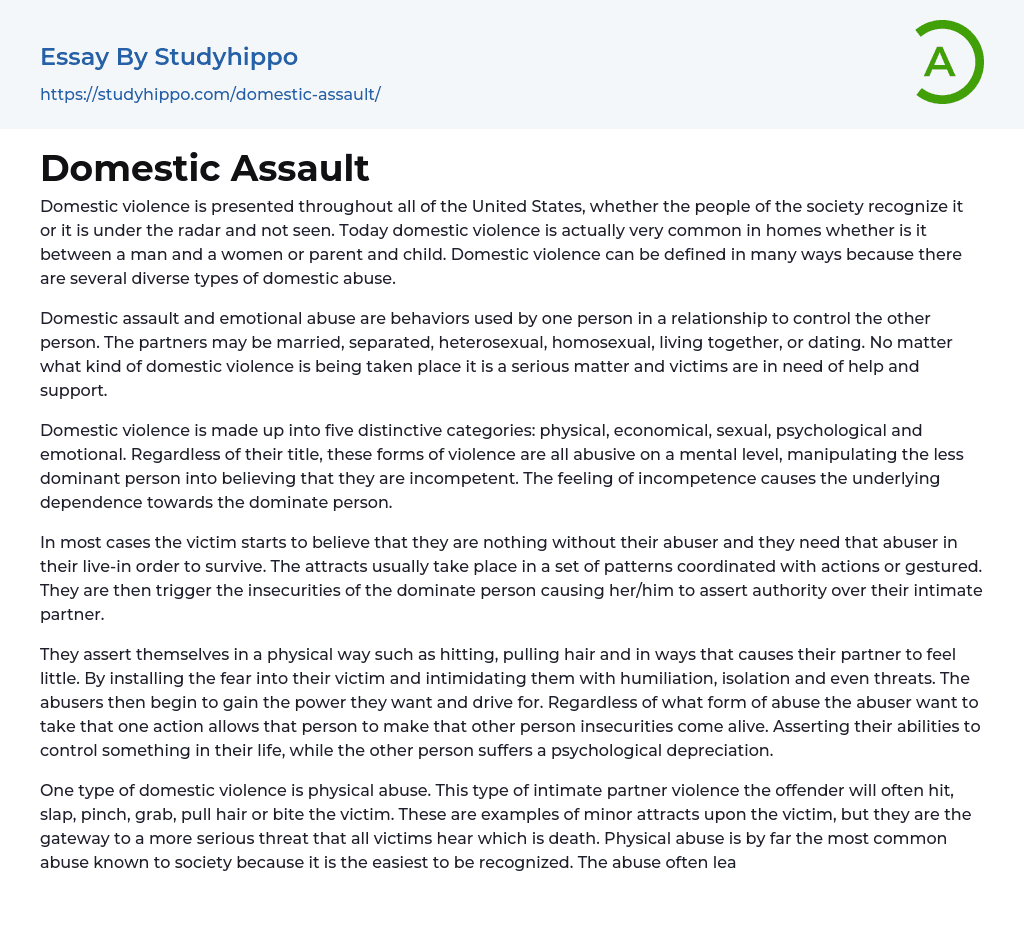Domestic violence affects all regions and demographics in the United States, being a prevalent issue that can be either openly acknowledged or concealed from public awareness. It is currently widespread within households, manifesting between couples and within parent-child relationships.
There are multiple ways to define various types of domestic abuse. Domestic violence includes behaviors like domestic assault and emotional abuse, which one partner uses to control the other person in a relationship. This can occur in different kinds of relationships, such as marriage, separation, heterosexual or homosexual partnerships, cohabitation, or dating. Regardless of the specific form of domestic violence, it is a serious problem that requires assistance and support for the victims. Domestic violence can be classified into five distinct forms: physical, economic, sexual, psychological, and emotional. These forms of violence all involve mental abuse a
...nd manipulation of the less dominant individual to create feelings of inadequacy.
The feeling of inadequacy leads to dependence on the dominant person. Often, the victim believes they are worthless without their abuser and rely on them for survival. These patterns of attraction typically involve coordinated actions or gestures that trigger insecurities in the dominant person, leading them to assert control over their partner. They exert this control physically through hitting and hair pulling, as well as emotionally by making their partner feel small. Through instilling fear, humiliation, isolation, and threats, they intimidate their victim.
At first, abusers attain the power they desire and work towards, regardless of the kind of abuse they partake in. This grants them the capability to exploit their victim's insecurities, exercise control in their personal life, and cause psychological harm to the other individual. Physical abuse is
distinct type of domestic violence where the perpetrator frequently resorts to physical actions like hitting, slapping, pinching, grabbing hair or biting their intimate partner.
The following text depicts less significant attractions undergone by victims, acting as a prelude to their ultimate dread: death. Physical abuse is easily identifiable and widely acknowledged in society. It frequently results in visible indications on the victim's body, such as bruises and marks around the neck from choking. In certain instances, perpetrators may try to portray the mistreatment as an unintentional incident, like pushing the victim downstairs or forcefully thrusting them against a wall or door.
The passage discusses the connection between domestic violence and the victim's apparent clumsiness, which allows the perpetrator to evade responsibility. Perpetrators often manipulate victims into creating false stories about how they acquired bruises or marks inflicted by them. If victims refuse to lie about their injuries' origins, the abuser will escalate harmful behavior in subsequent incidents. Additionally, sexual abuse is another form of domestic violence that involves non-consensual sexual activity, utilizing force, threats, and exploiting the victim's inability to give consent. In Pennsylvania's past legislation, rape within a marriage was considered impossible and forced sexual relations were not recognized within marital relationships.
Currently, there has been a development in the form of a new regulation. It states that if someone is forced to have sexual intercourse with their partner, it is no longer categorized as rape. However, this action is commonly known as sexual abuse when it takes place within the realm of domestic violence. Sexual abuse is classified as a type of mistreatment that involves both physical and emotional harm.
The perpetrator exercises control over the victim,
causing physical and emotional harm to make them feel inferior. They also use economic abuse by controlling and limiting the victim's finances, making it difficult for them to leave. Usually, the offender has full control of their bank account.
The perpetrator limits the victim's access to a particular account, allowing them to monitor the victim's whereabouts, control their finances, and observe their spending patterns. Moreover, the offender may also require the victim to provide receipts as an extra means of surveillance.
Emotional abuse is the fourth category of domestic violence, involving actions that diminish an individual's self-worth or self-esteem.




